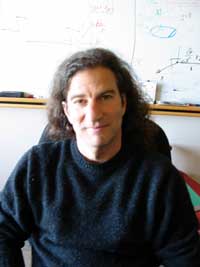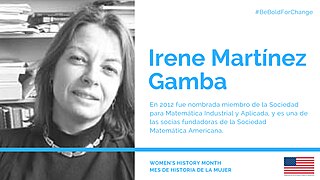
The Courant Institute of Mathematical Sciences is the mathematics research school of New York University (NYU). Founded in 1935, it is named after Richard Courant, one of the founders of the Courant Institute and also a mathematics professor at New York University from 1936 to 1972, and serves as a center for research and advanced training in computer science and mathematics. It is located on Gould Plaza next to the Stern School of Business and the economics department of the College of Arts and Science.

James Albert Sethian is a professor of mathematics at the University of California, Berkeley and the head of the Mathematics Group at the United States Department of Energy's Lawrence Berkeley National Laboratory.
Charles Samuel Peskin is an American mathematician known for his work in the mathematical modeling of blood flow in the heart. Such calculations are useful in the design of artificial heart valves. From this work has emerged an original computational method for fluid-structure interaction that is now called the “immersed boundary method", which allows the coupling between deformable immersed structures and fluid flows to be handled in a computationally tractable way. With his students and colleagues, Peskin also has worked on mathematical models of such systems as the inner ear, arterial pulse, blood clotting, congenital heart disease, light adaptation in the retina, control of ovulation number, control of plasmid replication, molecular dynamics, and molecular motors.

Katepalli Raju Sreenivasan is an aerospace scientist, fluid dynamicist, and applied physicist whose research includes physics and applied mathematics. He studies turbulence, nonlinear and statistical physics, astrophysical fluid mechanics, and cryogenic helium. He was the dean of engineering and executive vice provost for science and technology of New York University. Sreenivasan is also the Eugene Kleiner Professor for Innovation in Mechanical Engineering at New York University Tandon School of Engineering and a professor of physics and mathematics professor at the New York University Graduate School of Arts and Science and Courant Institute of Mathematical Sciences.
Silas D. Alben is an American mathematician. His is Professor of Mathematics and Director of the Applied and Interdisciplinary Mathematics Program at the University of Michigan. His research addresses problems from biology and engineering that can be studied with the tools of applied mathematics and continuum mechanics.

Paul Roesel Garabedian was a mathematician and numerical analyst. Garabedian was the Director-Division of Computational Fluid Dynamics at the Courant Institute of Mathematical Sciences, New York University. He is known for his contributions to the fields of computational fluid dynamics and plasma physics, which ranged from elegant existence proofs for potential theory and conformal mappings to the design and optimization of stellarators. Garabedian was elected a member of the National Academy of Sciences in 1975.
Percy Alec Deift is a mathematician known for his work on spectral theory, integrable systems, random matrix theory and Riemann–Hilbert problems.
Leslie Frederick Greengard is an American mathematician, physicist and computer scientist. He is co-inventor with Vladimir Rokhlin Jr. of the fast multipole method (FMM) in 1987, recognized as one of the top-ten algorithms of the 20th century.
James Arthur Krumhansl was an American physicist who specialized in condensed matter physics and materials science. He spent much of his career at Cornell University. He also served as president of the American Physical Society and assistant director for mathematics, physical sciences, and engineering for the National Science Foundation. In 1987 he testified before Congress that the Superconducting Super Collider would be too costly.
Marsha J. Berger is an American computer scientist. Her areas of research include numerical analysis, computational fluid dynamics, and high-performance parallel computing. She is a Silver Professor (emeritus) of Computer Science and Mathematics in the Courant Institute of Mathematical Sciences of New York University. She is Group Leader of Modeling and Simulation in the Center for Computational Mathematics at the Flatiron Institute.

Russel E. Caflisch is an American mathematician.
Thomas Yizhao Hou is the Charles Lee Powell Professor of Applied and Computational Mathematics in the Department of Computing and Mathematical Sciences at the California Institute of Technology. He is known for his work in numerical analysis and mathematical analysis.

Irene Martínez Gamba is an Argentine–American mathematician. She works as a professor of mathematics at the University of Texas at Austin, where she holds the W.A. Tex Moncrief, Jr. Chair in Computational Engineering and Sciences and is head of the Applied Mathematics Group in the Oden Institute for Computational Engineering and Sciences.

Lai-Sang Lily Young is a Hong Kong-born American mathematician who holds the Henry & Lucy Moses Professorship of Science and is a professor of mathematics and neural science at the Courant Institute of Mathematical Sciences of New York University. Her research interests include dynamical systems, ergodic theory, chaos theory, probability theory, statistical mechanics, and neuroscience. She is particularly known for introducing the method of Markov returns in 1998, which she used to prove exponential correlation delay in Sinai billiards and other hyperbolic dynamical systems.
Tamar Schlick is an American applied mathematician who works as a professor of chemistry, mathematics, and computer science at New York University. Her research involves developing and applying tools for modeling and simulating biomolecules.
Igor Mezić is a mechanical engineer, mathematician, and Distinguished Professor of mechanical engineering and mathematics at the University of California, Santa Barbara. He is best known for his contributions to operator theoretic, data driven approach to dynamical systems theory that he advanced via articles based on Koopman operator theory, and his work on theory of mixing, that culminated in work on microfluidic mixer design, and mapping oil refuse from the Deepwater Horizon oil spill in the Gulf of Mexico to aid in cleaning efforts.
Bernard Judah Matkowsky was an American applied mathematician.
Zheng Jane Wang is a Chinese and American physicist known for her research on insect flight. She is a professor of physics and of mechanical and aerospace engineering at Cornell University.






